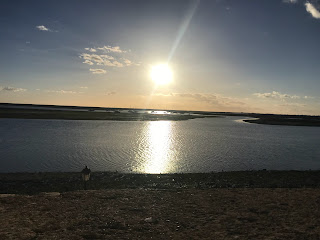We have been in our new Portuguese home exactly two months and love it here and miss our family in America so this blog is about some old and some new traditions
The White Stork (Ciconia cicnia) are a beloved traditional bird in the Algarve (it’s illegal to destroy a nest). Portugal has the distinction of harboring the only known White Stork that nest at sea Olhão however has several year-round nesting storks as we see them flying overhead and perching high on the church steeples in their nests. Like the Bald Eagles that used to occasionally & majestically fly by our window in Coeur d'Alene, Idaho, these storks swoop by our windows every day.
The town of Olhão is essentially and historically linked to the local fishing industry and only grew into existence in the 17th Century. It has about 30,000 inhabitants and was raised to the status of a town in 1808 after 17 local fishermen successfully crossed the Atlantic Ocean without charts in their small fishing boat "Bom Sucesso". Their purpose was to announce to the exiled King of Portugal, Dom João IV, that the French invading armies had been defeated and had returned to France leaving Portugal free for the King to return. It was in this town in 1882 that the first canning factory for tuna and sardines was established. Very soon canning it became the leading industry of the Algarve. |
 |
| Replica of the Bom Sucesso all decked out for Christmas |
Food is a passion in Portugal -served with love, family and conviviality. It's a very Portuguese thing to have food for 3 times the amount of people.
 |
| Se a ultima ceia tivesse sido em Portugal |
We enjoyed long video chats & phone calls with our families in the States watching our grandchildren open presents and then settled down to stuff ourselves with food!
Fish is traditionally eaten on Christmas Eve and it's usually Bacalhau-salted cod which is revered in Portugal even though it originates from the Northern sea by Norway and Iceland. It's unclear how this fish became Portugal's national dish but most theories say the fisherman preserved the cod in salt for their journey back to Portugal. By the time they arrived back to Portugal, they would often have leftover bacalhau which they would then sell to the local people. Today it is still heavily salted and stacked in non-refrigerated piles in the market-then it must be soaked in water for several days to leach out the salt.
We had Bacalhau, fresh shrimp followed by the usual fruit for dessert. I baked pineapple for dessert that I followed the recipe in Portuguese!
 |
| buying camarao (shrimp) at the fish market. Yes, that's €13 kg which works out about $6.00/lb |
 |
| Appetizer-Shrimp Paté, Olives (..always in Portugal!) with Martinis |
 |
| First Course-Cream of Pumpkin soup with Valle do Rico Homen Reserva Wine (have I mentioned how reasonable the everyday wine is here? This was about $2.50 a bottle) |
 |
| Main Courses (we added additional mashed potatoes) |
 |
| Cheese with Port Wine (those are smaller dessert wine glasses...really!!) |
Sending our warmest wishes and love to all for the Holidays. (and special HUGS & KISSES to sister-in-law Jan and our nephew Jackson, who were involved in a serious car wreck on Christmas Eve in New Jersey. They both walked away-a Christmas miracle!)



















































































